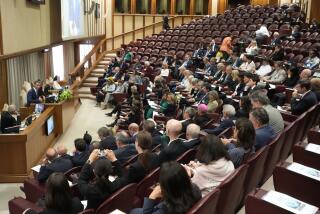Greening of Faiths Has Many Shades of Meaning
Across the country, congregations of many faiths are awakening to a kind of earth spirituality rooted in their sacred writings and traditions.
Mainline Protestants and Roman Catholics have been among the leaders in the charge, incorporating themes of caring for creation into their prayers, sermons and liturgies. But there is a growing, though still nascent, awareness among evangelicals and Pentecostal Christians, who also see the worldâs environmental problems essentially as a crisis of the spirit.
One example of the increasing number of environment-oriented rituals will unfold this weekend as Jewish congregations mark Tu BâShevat, a holiday that has evolved into something of a Jewish Earth Day. In many congregations the day becomes a time to reflect on humanityâs place in the natural order and on scriptural injunctions to redeem the land. In modern Israel, the day is associated with reclaiming the desert for agriculture.
âFive years ago many Jews questioned whether the environment was a Jewish issue,â said Rabbi Mark X. Jacobs, director of the Coalition on the Environment and Jewish Life, based in New York.
Today that attitude has changed significantly.
Against the dramatic backdrop of the San Gabriel Mountains on Sunday, a group under the auspices of the Jewish National Fund--including U.S. Secretary of Agriculture Dan Glickman and representatives of major environmental organizations--will host ceremonies, nature walks and tree plantings in the Angeles National Forest just above Azusa.
Other congregations in the region will engage in local efforts at environmental improvement. For example, BâNai David, an Orthodox congregation in the Pico-Robertson area of Los Angeles, will lead an effort to plant trees along a commercial strip of Pico Boulevard.
Religious leaders in other faiths are developing educational materials, model worship services and sermon outlines for use by congregations and pastors.
*
Perspectives on religious environmentalism vary. Although white churches tend to see the issue as a crisis in spirit, African American churches for the most part focus on civic activism. Efforts to oppose a toxic waste dump in a poor neighborhood, for example, resonate more than abstract ideas about âcaring for creation,â African American church leaders say.
âThere are some shining [exceptions]. But African American churches still have a hard time for the most part understanding the need to use their faith as a way of going into action around these issues,â said the Rev. Eugene Williams, executive director of Los Angeles Metropolitan Churches, an association of small to medium-size African American congregations.
Among Christians, one of the most notable efforts is the observance of the blessing of the animals on St. Francis day at the Cathedral of St. John the Divine in New York.
âWhen the two-ton bronze doors of the cathedral open up and there is a procession of animals down a nave the length of two football fields, the place goes very silent and there are more than a few people with tears,â said Paul Gorman of the National Religious Partnership for the Environment.
âI have asked myself what are those tears? As nearly as I can understand it, I think those are tears that express both the recognition of alienation between humankind and the rest of creation and the yearning for reconciliation.â
Earth spirituality has long been a part of many faiths. Buddhism, for example, offers a holistic world view that fosters respect for the created order. In Jainism the protection of animals is a central feature of religious observances. Native Americans are renowned for their regard for the sacredness of nature.
In Islam, there is no single day set aside to consider the protection of creation. But there is a developing sense among Muslim leaders that they must apply Koranic teachings to contemporary environmental problems.
During drought conditions in California several years ago, Maher Hathout, spokesman with the Islamic Center of Southern California near downtown Los Angeles, said that Friday worship observances were an occasion to preach about the sacredness of water.
âThe Koran considers water as a blessing [that] should not be wasted,â Hathout said. âThere is a teaching that you do not waste water even if you are at the river.â
Such ancient injunctions, found in many faiths, are becoming a way of inviting believers to consider environmental issues within the context of their faiths--to repair and preserve the natural world not as a political act but as an act of faith and respect for the created order.
*
Those efforts are causing some congregations to reconsider the meaning of old symbols. At the Lutheran Church in the Foothills in La Canada Flintridge, for example, an 85-foot statue stands with arms raised toward the San Gabriel Mountains. When the statue was erected in 1965, the church undoubtedly had other interpretations of faith and adoration in mind.
But Pastor James C. Kniseley said he can see how the inscription of the 121st Psalm on the base of statue can instill awe for God as well as Godâs creation and lend itself to a âgreenâ reading: âI will lift up my eyes to the hills. From whence does my help come? My help comes from the Lord, who made heaven and earth.â
With the greening of faith, environmental concerns are finding their way into formal prayers and liturgies with orthodox expressions of faith that also seek to stretch the worship experience to contemplate the created order.
One of the early contemporary expressions of âcaring for creationâ is found in the 1979 Book of Common Prayer used by the Episcopal Church. It includes an alternative Eucharistic rite that pays homage to God as creator: âAt your command all things came to be: the vast expanse of interstellar space, galaxies, suns, the planets in their courses, and this fragile earth, our island home.â
Perhaps more surprising has been the heightened awareness of evangelical and Pentecostal Christians, many of whom in past years have either been suspicious of environmentalism as a liberal political concern, or wary that to speak of it in religious terms risked a slippery slope toward paganism, idolatry or polytheism.
Now, however, the Evangelical Environmental Network is encouraging congregations to consider observing April 2 as âCreation Sunday.â A model worship service and sermon outlines are being provided to pastors who wish to participate.
More than 150 pastors have responded, said the Rev. Jim Ball, executive director of the Evangelical Environmental Network.
Like the Jewish faithful at Sundayâs Tu BâShevat service and tree planting, evangelicals are incorporating environmental themes into their worship services.
âWeâre dealing with mystery here,â said Ball. âYou are dealing with the mystery of the body of Christ when believers come together for worship. Thatâs a completely different experience than taking a class or even reading Scripture on your own. . . . But thereâs just no substitute for the corporate act of worship in experiencing the Holy Spirit in a way that enhances our desire to care for creation.â
More to Read
Sign up for Essential California
The most important California stories and recommendations in your inbox every morning.
You may occasionally receive promotional content from the Los Angeles Times.










